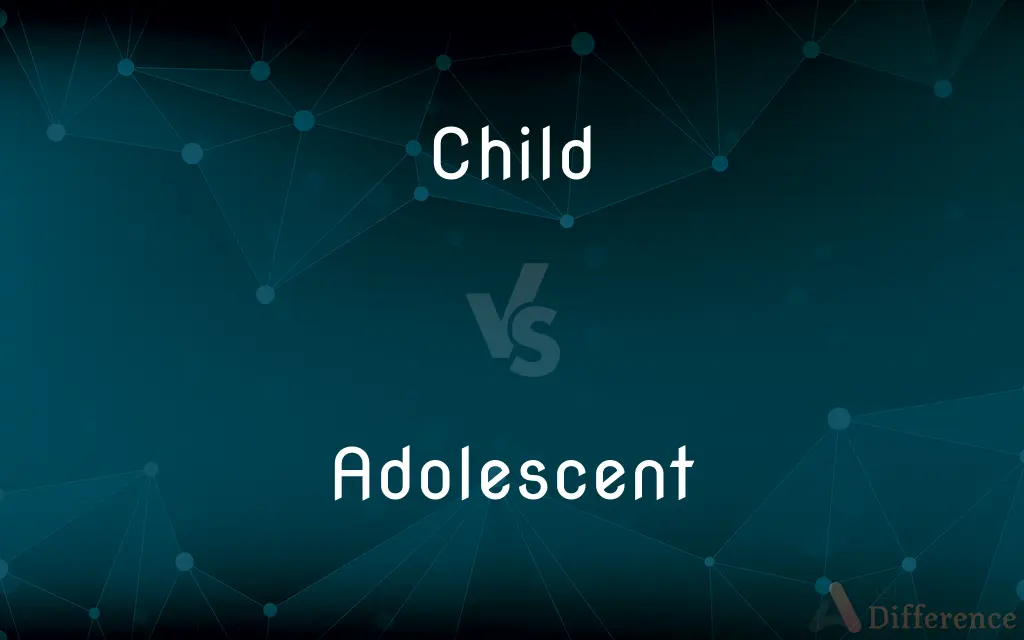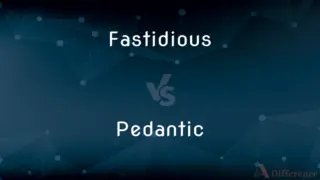Child vs. Adolescent — What's the Difference?
By Tayyaba Rehman & Fiza Rafique — Updated on March 19, 2024
A child is a person in the early stages of life, typically under the age of 12, whereas an adolescent is a person in the transitional phase between childhood and adulthood, typically between ages 13 and 19.

Difference Between Child and Adolescent
Table of Contents
ADVERTISEMENT
Key Differences
Children are in the initial phase of their lives, encompassing infancy to the pre-teen years, during which they experience significant physical, cognitive, and emotional development. They rely heavily on adults for care, guidance, and education. Adolescents, on the other hand, are in a transitional stage, navigating the complex journey from childhood to adulthood, characterized by significant physical changes due to puberty, as well as evolving cognitive abilities and social identities.
In terms of physical development, children grow at a steady pace, and their bodies gradually become more coordinated and capable. Adolescents undergo more dramatic physical changes, including growth spurts and the development of secondary sexual characteristics, as their bodies transition to an adult form.
Cognitively, children's thinking is more concrete and centered around immediate experiences and environments. Adolescents begin to develop abstract thinking skills, allowing them to ponder hypothetical situations, grapple with moral dilemmas, and consider future possibilities, reflecting a significant expansion in their cognitive abilities.
Socially, children's interactions are typically centered around family and play with peers, serving as a foundation for learning social norms and behaviors. Adolescents, while still influenced by their families, increasingly turn to their peer group for social cues and identity formation, often experimenting with different roles and behaviors as they seek to establish their independence and individuality.
Emotionally, children are learning to identify, express, and manage their emotions with the help of adult guidance. Adolescents face more complex emotional landscapes, as the physical and social changes of puberty coincide with a search for personal identity, often leading to increased introspection, emotional intensity, and conflict with parents as they push for more autonomy.
ADVERTISEMENT
Legally and culturally, the distinction between a child and an adolescent can affect rights, responsibilities, and expectations. Children are generally afforded more protection under the law and are subject to compulsory education, while adolescents may begin to gain certain adult privileges, such as working, driving, or participating in more mature social activities, depending on jurisdictional laws.
Comparison Chart
Age Range
Infancy to pre-teen (0-12 years)
Teen years (13-19 years)
Physical Development
Steady growth, basic motor skills development
Puberty, growth spurts, secondary sexual characteristics
Cognitive Development
Concrete thinking, focused on immediate surroundings
Development of abstract and hypothetical thinking
Social Interaction
Centered around family and simple peer play
Peer influence grows, experimentation with social roles
Emotional Development
Learning basic emotion management
Complex emotional experiences, identity exploration
Legal/Cultural Status
Protected, compulsory education
Transitioning to adult privileges/responsibilities
Compare with Definitions
Child
A young human being below the age of puberty or below the legal age of majority.
The child spent hours playing with his toys.
Adolescent
A person in the transitional phase of physical and psychological development between childhood and adulthood.
The adolescent was becoming more interested in expressing his individuality.
Child
Often dependent on adults for basic needs and guidance.
She guided her child through the basics of reading and writing.
Adolescent
Experiences significant growth and changes due to puberty.
She noticed her adolescent son had grown taller over the summer.
Child
Socially engages primarily through play and learning.
The child enjoyed making new friends at the playground.
Adolescent
Begins to develop more complex, abstract thinking abilities.
The adolescent engaged in debates on various global issues.
Child
Navigates basic emotional expressions and understanding.
The child felt proud after building a tall block tower.
Adolescent
Faces more complex emotional challenges and seeks independence.
The adolescent struggled with mood swings but was learning to manage them.
Child
In a phase of rapid physical and cognitive development.
The child's ability to solve complex puzzles surprised everyone.
Adolescent
Social interactions often revolve around peer relationships and identity exploration.
The adolescent found a sense of belonging in her sports team.
Child
Biologically, a child (plural children) is a human being between the stages of birth and puberty, or between the developmental period of infancy and puberty. The legal definition of child generally refers to a minor, otherwise known as a person younger than the age of majority.
Adolescent
Of, relating to, or undergoing adolescence.
Child
A person between birth and puberty.
Adolescent
Characteristic of adolescence; immature
An adolescent sense of humor.
Child
A person who has not attained maturity or the age of legal majority.
Adolescent
A young person who has undergone puberty but who has not reached full maturity.
Child
An unborn infant; a fetus.
Adolescent
Of, relating to, or at the age of adolescence; at the stage between being a child and an adult.
Child
An infant; a baby.
Adolescent
A person who is in adolescence; someone who has reached puberty but is not yet an adult.
Child
One who is childish or immature.
Adolescent
Growing; advancing from childhood to maturity.
Schools, unless discipline were doubly strong,Detain their adolescent charge too long.
Child
Someone to whom a specified person is a parent.
Adolescent
A youth.
Child
A member of a tribe; descendant
Children of Abraham.
Adolescent
A juvenile between the onset of puberty and maturity
Child
An individual regarded as strongly affected by another or by a specified time, place, or circumstance
A child of nature.
A child of the Sixties.
Adolescent
Relating to or peculiar to or suggestive of an adolescent;
Adolescent problems
Child
A product or result of something specified
“Times Square is a child of the 20th century” (Richard F. Shepard).
Adolescent
Being of the age 13 through 19;
Teenage mothers
The teen years
Child
A person who has not yet reached adulthood, whether natural (puberty), cultural (initiation), or legal (majority).
Go easy on him: he is but a child.
Adolescent
Displaying or suggesting a lack of maturity;
Adolescent insecurity
Jejune responses to our problems
Their behavior was juvenile
Puerile jokes
Child
A kid aged 1 to 11 years, whereas neonates are aged 0 to 1 month, infants are aged 1 month to 12 months, and adolescents are aged 12 years to 18 years.
Regular chores can be appropriate for both children and adolescents, given age-appropriate limits on difficulty level and time on task.
Adolescent
In the state of development between puberty and maturity;
Adolescent boys and girls
Child
(with possessive) One's direct descendant by birth, regardless of age; one's offspring; a son or daughter.
My youngest child is forty-three this year.
His adult children visit him yearly.
Child
(cartomancy) The thirteenth Lenormand card.
Child
(figurative) A figurative offspring, particularly:
Child
A person considered a product of a place or culture, a member of a tribe or culture, regardless of age.
The children of Israel.
He is a child of his times.
Child
Anything derived from or caused by something.
Child
(computing) A data item, process, or object which has a subservient or derivative role relative to another.
The child node then stores the actual data of the parent node.
Child
Youth of noble birth
Child
(mathematics) A subordinate node of a tree.
Child
A female child, a girl.
Child
To give birth; to beget or procreate.
Child
A son or a daughter; a male or female descendant, in the first degree; the immediate progeny of human parents; - in law, legitimate offspring. Used also of animals and plants.
Child
A descendant, however remote; - used esp. in the plural; as, the children of Israel; the children of Edom.
Child
One who, by character of practice, shows signs of relationship to, or of the influence of, another; one closely connected with a place, occupation, character, etc.; as, a child of God; a child of the devil; a child of disobedience; a child of toil; a child of the people.
Child
A noble youth. See Childe.
Child
A young person of either sex. esp. one between infancy and youth; hence, one who exhibits the characteristics of a very young person, as innocence, obedience, trustfulness, limited understanding, etc.
When I was child. I spake as a child, I understood as a child, I thought as a child; but when I became a man, I put away childish things.
Child
A female infant.
A boy or a child, I wonder?
Child
To give birth; to produce young.
This queen Genissa childing died.
It chanced within two days they childed both.
Child
A young person of either sex;
She writes books for children
They're just kids
`tiddler' is a British term for youngsters
Child
A human offspring (son or daughter) of any age;
They had three children
They were able to send their kids to college
Child
An immature childish person;
He remained a child in practical matters as long as he lived
Stop being a baby!
Child
A member of a clan or tribe;
The children of Israel
Common Curiosities
Can the end of adolescence vary from person to person?
Yes, the end of adolescence can vary due to individual differences in physical, cognitive, and social development.
What is the primary difference between a child and an adolescent?
The primary difference lies in the developmental stage; children are in early development, while adolescents are transitioning to adulthood, marked by puberty and cognitive changes.
How do parenting roles change from childhood to adolescence?
Parenting roles shift from direct care and guidance in childhood to more of a supportive and advisory role during adolescence as adolescents seek more independence.
At what age does adolescence begin?
Adolescence typically begins around the age of 13.
What are some key challenges adolescents face?
Adolescents face challenges such as navigating social relationships, establishing an identity, and managing the emotional and physical changes of puberty.
Why is play important for children?
Play is crucial for children's social, emotional, cognitive, and physical development, helping them learn about the world and develop key skills.
How does peer influence change from childhood to adolescence?
While peers are important in both stages, adolescents are more likely to be influenced by their peer group in forming their identity and making decisions.
What cognitive changes occur during adolescence?
Adolescents develop the ability to think abstractly, reason logically, and consider hypothetical situations.
How do schools accommodate the transition from childhood to adolescence?
Schools often accommodate this transition by adjusting academic expectations, offering more complex and diverse subjects, and providing support for emotional and social development.
What role does puberty play in adolescence?
Puberty is a central aspect of adolescence, involving physical changes that transition the individual from a child to a physically mature adult.
Share Your Discovery

Previous Comparison
Fastidious vs. Pedantic
Next Comparison
Dah vs. DitAuthor Spotlight
Written by
Tayyaba RehmanTayyaba Rehman is a distinguished writer, currently serving as a primary contributor to askdifference.com. As a researcher in semantics and etymology, Tayyaba's passion for the complexity of languages and their distinctions has found a perfect home on the platform. Tayyaba delves into the intricacies of language, distinguishing between commonly confused words and phrases, thereby providing clarity for readers worldwide.
Co-written by
Fiza RafiqueFiza Rafique is a skilled content writer at AskDifference.com, where she meticulously refines and enhances written pieces. Drawing from her vast editorial expertise, Fiza ensures clarity, accuracy, and precision in every article. Passionate about language, she continually seeks to elevate the quality of content for readers worldwide.
















































